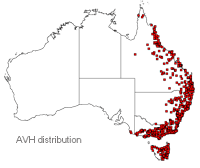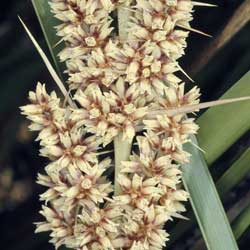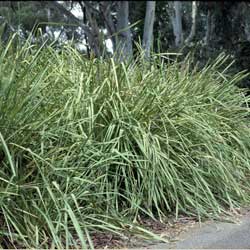Lomandra longifolia
Spiny-head Mat-rush, Basket Grass
 Lomandra longifolia (Spiny-head Mat-rush or Basket Grass) is native Australia-wide except for the Northern Territory and Western Australia. A member of the Xanthorrhoeaceae family, it can grow in a range of sandy soils, in swamps and wet places to the montane zone on banks of creeks, rocky hillsides, cliffs and open forests.
Lomandra longifolia (Spiny-head Mat-rush or Basket Grass) is native Australia-wide except for the Northern Territory and Western Australia. A member of the Xanthorrhoeaceae family, it can grow in a range of sandy soils, in swamps and wet places to the montane zone on banks of creeks, rocky hillsides, cliffs and open forests.
L. longifolia is a perennial, rhizomatous herb. Leaves are glossy green, shiny, firm, and flat. They can grow from 40 cm up to 1 m long and 8-12 mm wide and are usually taller than the flowering stem. Leaf bases are broad with yellow, orange or brownish margins and the tips of the leaves are prominently toothed.
The inflorescence is usually a panicle of clusters of sessile flowers. Each cluster has a sharp, slender, straw-coloured bract at its base, which gives it a dense spike-like structure. The inflorescence is usually about half the leaf length (c. 50 cm) and individual flowers are about 4 mm long. Flowers of L. longifolia are scented and dioecious, with the female flower often a little bit longer or larger than the male. The heavy-smelling nectar of flowers can attract pollinating beetles. Flowering occurs in warm temperature conditions (late winter/early spring); fruiting occurs 1–2 months after flowering.
The clustered flower head is always shown as brown seed capsules throughout the year. During the flowering period, sepals are shiny brown, thin and papery, while the petals are fleshy and creamy-yellow coloured.
L. longifolia is suitable for growing indoors in containers as well as outdoors and requires moist soil for growth. However, its thick leaves and the extensive root system help plants tolerate dryness. It can grow in a wide range of soil from light (sandy) to heavy (clay) soil. There is no special soil pH requirement and it can grow in semi-shaded areas, like light woodland, or in non-shaded areas.
It is relatively easy to maintain L. longifolia. Moist soil is required for growth of the plant, but it would not usually die without watering. It is highly tolerant to dryness and does not have any known issues with pests and diseases.
L. longifolia can be propagated by seed or via clump division. When the fruits are mature and turn brown, sow the seed in moist soil in a greenhouse or outdoors. Germination usually occurs within six weeks.Clump division is achieved by cutting each clump in half and planting them in moist soil indoors or outdoors.
There is little cultivation limitation for this plant in Australia. L. longifolia is highly drought-tolerant but also can tolerate occasional flooding, withstand low temperature down to -7°C, and succeeds in moist soil almost anywhere in Australia. However, plants can die back in a wet winter and do not survive well in areas with cooler summers.
Aboriginal people use the leaves of L. longifolia to make strong nets and baskets, and they consume the starchy leaf-bases as a food.
Text by Kate Tak Yee Ko (2007 Botanical Intern) [since modified online]
Photos: M.Fagg
Name Meaning: Lomandra longifoliaLomandra – from Loma- (Greek) meaning edge, border and aner, man, male, because of the bordered anthers of some species. longifolia – from longi- (Latin) meaning long and -folia (Latin) meaning leaf. |
References
New South Wales Department of Agriculture (1966) Flora of New South Wales. Xanthorrhoeaceae. No.34. pp.16
Stewart, A. (2004) Gardening Australia, Flora’s Native Plants a Definitive Guide to Australian Plants, Annuals and perennials ABC Books, Australia, p.72
Wrigley, J. and Fagg, M. (2003) Australian Native Plants - Cultivation, Use in Landscaping and Propagation, (5th edition), Australia, pp. 173-174
Morwell National Park Online. [Internet resources: http://morwellnp.pangaean.net/cgi-bin/show_species.cgi?find_this=Lomandra%20longifolia&image_size=0, accessed on 08/02/07]Joe McAuliffe. Australian National Botanic Garden. Personal communication
![An Australian Government Initiative [logo]](/images/austgovt_brown_90px.gif)



